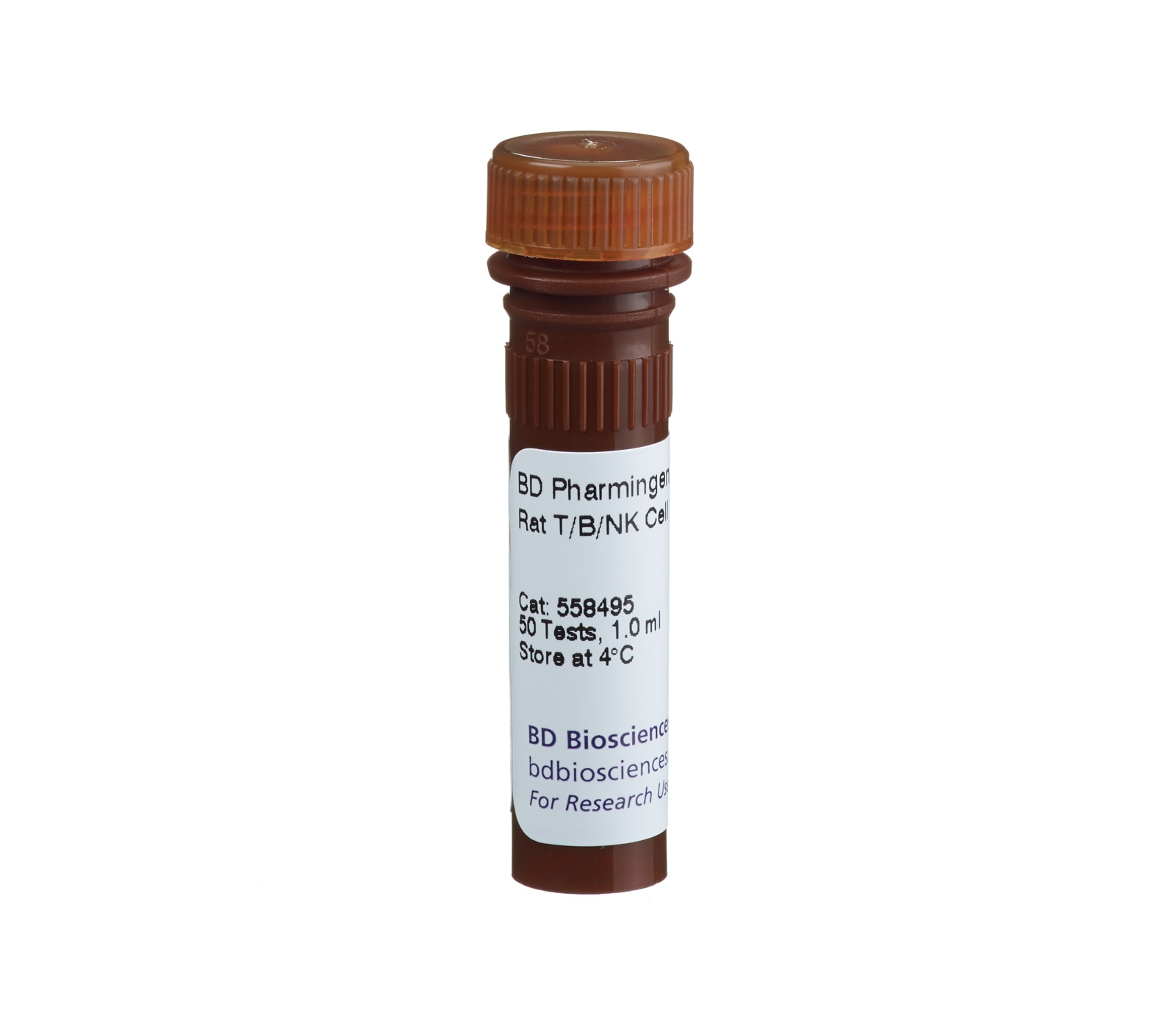Old Browser
Looks like you're visiting us from {countryName}.
Would you like to stay on the current country site or be switched to your country?
BD Pharmingen™ Rat T/B/NK Cell Cocktail
(RUO)



Three color analysis of the expression of CD3, CD45RA and CD161a/NKR-P1A on rat splenocytes. A single cell suspension of Lewis splenocytes was stained with either Isotype Control Cocktail - A (Cat. no. 558509, data not shown) or Rat T/B/NK Cocktail (Cat. no. 558495). The figure on the left represents the CD3 and CD45RA profile gating on whole spleen. The figure on the right represents the CD3 and CD161a/NKR-P1A profile gating on whole spleen. Flow cytometry was performed on a BD FACSCalibur™ instrument.


BD Pharmingen™ Rat T/B/NK Cell Cocktail

Rat T/B/NK Cell Cocktail
Regulatory Status Legend
Any use of products other than the permitted use without the express written authorization of Becton, Dickinson and Company is strictly prohibited.
Description
The Rat T/B/NK Cocktail is a three-color reagent cocktail designed to identify rat T, B, and NK lymphocyte populations by direct immunofluorescent staining with flow cytometric analysis. The monoclonal antibody clone 1F4 has been reported to react with the T-cell receptor-associated CD3 cell-surface antigen found on thymocytes and peripheral T lymphocytes. The monoclonal antibody clone OX-33 has been reported to react with CD45RA found only on B lymphocytes. The monoclonal antibody clone 10/78 has been reported to react with NKR-P1A (CD161a), 60-kDa homodimer expressed on all natural killer (NK) cells and a small subset of T lymphocytes.
Preparation And Storage
Recommended Assay Procedures
BD® CompBeads can be used as surrogates to assess fluorescence spillover (compensation). When fluorochrome conjugated antibodies are bound to BD® CompBeads, they have spectral properties very similar to cells. However, for some fluorochromes there can be small differences in spectral emissions compared to cells, resulting in spillover values that differ when compared to biological controls. It is strongly recommended that when using a reagent for the first time, users compare the spillover on cell and BD® CompBeads to ensure that BD® CompBeads are appropriate for your specific cellular application.
Product Notices
- Since applications vary, each investigator should titrate the reagent to obtain optimal results.
- Source of all serum proteins is from USDA inspected abattoirs located in the United States.
- Caution: Sodium azide yields highly toxic hydrazoic acid under acidic conditions. Dilute azide compounds in running water before discarding to avoid accumulation of potentially explosive deposits in plumbing.
- Please refer to www.bdbiosciences.com/us/s/resources for technical protocols.
- Please refer to http://regdocs.bd.com to access safety data sheets (SDS).
- For fluorochrome spectra and suitable instrument settings, please refer to our Multicolor Flow Cytometry web page at www.bdbiosciences.com/colors.
- This APC-conjugated reagent can be used in any flow cytometer equipped with a dye, HeNe, or red diode laser.
| Description | Quantity/Size | Part Number | EntrezGene ID |
|---|---|---|---|
| PE anti-Rat CD161a | N/A | 51-550-22645 | N/A |
| APC anti-Rat CD3 | N/A | 51-590-22739 | N/A |
| FITC anti-Rat CD45RA | N/A | 51-540-22174 | N/A |
Development References (3)
-
Kraus E, Lambracht D, Wonigeit K, Hunig T. Negative regulation of rat natural killer cell activity by major histocompatibility complex class I recognition. Eur J Immunol. 1996; 26(11):2582-2586. (Biology). View Reference
-
Tanaka T, Masuko T, Yagita H, Tamura T, Hashimoto Y. Characterization of a CD3-like rat T cell surface antigen recognized by a monoclonal antibody.. J Immunol. 1989; 142(8):2791-2795. (Biology). View Reference
-
Woollett GR, Barclay AN, et al. Molecular and antigenic heterogeneity of the rat leukocyte common antigen from thymocytes and T and B lymphocytes. . Eur J Immunol. 1985; 15:168-173. (Biology).
Please refer to Support Documents for Quality Certificates
Global - Refer to manufacturer's instructions for use and related User Manuals and Technical data sheets before using this products as described
Comparisons, where applicable, are made against older BD Technology, manual methods or are general performance claims. Comparisons are not made against non-BD technologies, unless otherwise noted.
For Research Use Only. Not for use in diagnostic or therapeutic procedures.
Refer to manufacturer's instructions for use and related User Manuals and Technical Data Sheets before using this product as described.
Comparisons, where applicable, are made against older BD technology, manual methods or are general performance claims. Comparisons are not made against non-BD technologies, unless otherwise noted.
Report a Site Issue
This form is intended to help us improve our website experience. For other support, please visit our Contact Us page.
